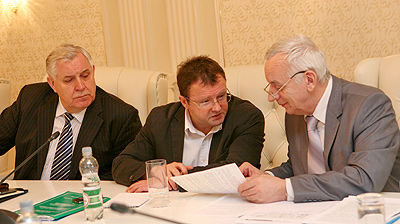Ru
|
Eng
Public survey of Belarus NPP environmental impact reviewed in Minsk
13.12.2013

Results of the radiation survey in the area around the construction site of the Belarusian nuclear power plant (NPP) were presented at the roundtable organized by the Belarusian Ecological Initiative non-governmental association in Minsk on 13 December, BelTA learned.
The meeting summed up the results of the project "Public monitoring of the environmental impact of the Belarusian nuclear power plant” carried out in 2013 on the initiative of a number of Belarusian environmental organizations.
Within the framework of the project volunteers from the environmental non-governmental organizations and experts of the national center of radiation control and monitoring of the Ministry of Natural Resources and Environment of Belarus did measurements of gamma radiation and collected samples of soil, water and air for caesium-137 and strontium-90 around the NPP construction site and nearby villages of Goza and Trokeniki. In addition, they did laboratory radionuclide analysis of the samples of surface water taken from the Vilia River, the main water artery flowing near the nuclear plant construction site.
"The results have shown that the radiation situation in the region around the construction site of the Belarusian nuclear power plant is stable. The levels of radioactive contamination of the natural environment are extremely low," said the head of the Ecological Initiative association Yuri Solovyov. The level of contamination of soil and surface water corresponds to the levels prior to the Chernobyl accident. The volumetric activity of caesium-137 in all samples of air and groundwater was below the minimum detectable activity of the laboratory analytical instruments used in the research.
Yuri Solovyov also noted that the results of the survey were as expected. "The construction of the nuclear power plant in Ostrovets has been professional and efficient. This is a modern and innovative project developed by recognized experts of the nuclear industry - the St. Petersburg-based institute Atomenergoproject. Therefore, the probability that a nuclear power plant will have a negative impact on the environment at the stage of construction is extremely low,” he said.
The main objective of the project is to create an information databank for the regular independent monitoring of the impact of the Belarusian nuclear power plant on the environment at all stages of its life cycle: construction, operation and decommissioning. "If there are any major deviations from the indicators we received during this survey, we will immediately inform the authorities and the public so that they could take measures to prevent negative effects for human health and the environment, said Yuri Solovyov.
This year the public monitoring project grew international. It was joined by Lithuanian and Russian environmentalists. Negotiations are in progress with Latvian, Finnish and French environmental non-governmental organizations. Next year's plans are to involve Lithuanian specialists in the field and laboratory studies to evaluate the radiation situation around the construction site of the NPP in Belarus.
“Implementation of such projects as the environmental monitoring shows that Belarus has formed a system of public monitoring in nuclear energy,” said Yuri Solovyov.
The meeting summed up the results of the project "Public monitoring of the environmental impact of the Belarusian nuclear power plant” carried out in 2013 on the initiative of a number of Belarusian environmental organizations.
Within the framework of the project volunteers from the environmental non-governmental organizations and experts of the national center of radiation control and monitoring of the Ministry of Natural Resources and Environment of Belarus did measurements of gamma radiation and collected samples of soil, water and air for caesium-137 and strontium-90 around the NPP construction site and nearby villages of Goza and Trokeniki. In addition, they did laboratory radionuclide analysis of the samples of surface water taken from the Vilia River, the main water artery flowing near the nuclear plant construction site.
"The results have shown that the radiation situation in the region around the construction site of the Belarusian nuclear power plant is stable. The levels of radioactive contamination of the natural environment are extremely low," said the head of the Ecological Initiative association Yuri Solovyov. The level of contamination of soil and surface water corresponds to the levels prior to the Chernobyl accident. The volumetric activity of caesium-137 in all samples of air and groundwater was below the minimum detectable activity of the laboratory analytical instruments used in the research.
Yuri Solovyov also noted that the results of the survey were as expected. "The construction of the nuclear power plant in Ostrovets has been professional and efficient. This is a modern and innovative project developed by recognized experts of the nuclear industry - the St. Petersburg-based institute Atomenergoproject. Therefore, the probability that a nuclear power plant will have a negative impact on the environment at the stage of construction is extremely low,” he said.
The main objective of the project is to create an information databank for the regular independent monitoring of the impact of the Belarusian nuclear power plant on the environment at all stages of its life cycle: construction, operation and decommissioning. "If there are any major deviations from the indicators we received during this survey, we will immediately inform the authorities and the public so that they could take measures to prevent negative effects for human health and the environment, said Yuri Solovyov.
This year the public monitoring project grew international. It was joined by Lithuanian and Russian environmentalists. Negotiations are in progress with Latvian, Finnish and French environmental non-governmental organizations. Next year's plans are to involve Lithuanian specialists in the field and laboratory studies to evaluate the radiation situation around the construction site of the NPP in Belarus.
“Implementation of such projects as the environmental monitoring shows that Belarus has formed a system of public monitoring in nuclear energy,” said Yuri Solovyov.
BELNPP: NEWS FROM CONSTRUCTION SITE
23.07.2024
11.07.2024
28.06.2024
06.06.2024
04.06.2024
04.06.2024
03.06.2024
24.05.2024
23.05.2024
03.05.2024













